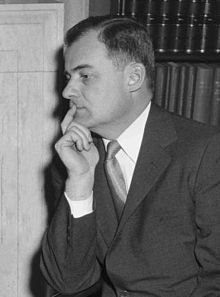Frederick Chapman Robbins
Frederick Chapman Robbins (born August 25, 1916 in Auburn , Alabama , USA , † August 4, 2003 in Cleveland , Ohio , USA) was an American microbiologist and pediatrician . In 1954 he received the Nobel Prize in Physiology or Medicine .
Life
Robbins was born the son of two botany professors William J. and Christine Robbins. He made an early decision to study medicine and began studying at the University of Missouri after graduating from high school . In 1938 he received his bachelor 's degree and continued his studies at Harvard Medical School in Cambridge (Massachusetts) . In 1940 he received his doctorate there and employed as a bacteriologist at the Central Children's Hospital in Boston . During the Second World War he worked in army service from 1942 as head of the Department of Viral and Rickettsiae Diseases of the 15th Medical General Laboratory in North Africa, in the USA and in Italy on research into hepatitis B , typhoid and Q fever .
After his marriage to Alice Northrop, he continued his work at the children's hospital and joined the research group of John Franklin Enders and Thomas Huckle Weller , who worked on infectious diseases. Here one was able to create cultures with the poliovirus . This led to the creation of a vaccine for polio. For this he received the Nobel Prize for Medicine in 1954 together with Enders and Weller. The American Philosophical Society awarded him their Benjamin Franklin Medal in 1999 .
Until his death on August 4, 2003, he worked as a professor (emeritus) of pediatrics at the Case Western Reserve University School of Medicine (Cleveland). He was a member of the National Academy of Sciences , and in 1962 he was elected to the American Academy of Arts and Sciences .
literature
- Frederick C. Robbins , in: Internationales Biographisches Archiv 45/2003 of October 27, 2003, in the Munzinger archive ( beginning of the article freely available)
Web links
- Information from the Nobel Foundation on the 1954 award ceremony for Frederick Chapman Robbins (English)
Individual evidence
- ^ Renate Wagner: Robbins, Frederick Chapmann. In: Werner E. Gerabek , Bernhard D. Haage, Gundolf Keil , Wolfgang Wegner (eds.): Enzyklopädie Medizingeschichte. De Gruyter, Berlin / New York 2005, ISBN 3-11-015714-4 , p. 1254 f.
| personal data | |
|---|---|
| SURNAME | Robbins, Frederick Chapman |
| BRIEF DESCRIPTION | American medic |
| DATE OF BIRTH | August 25, 1916 |
| PLACE OF BIRTH | Auburn , Alabama |
| DATE OF DEATH | August 4, 2003 |
| Place of death | Cleveland , Ohio |
